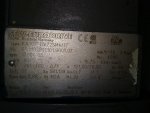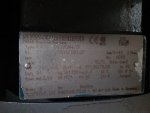drummin89
Member
- Location
- Hazle Township, Pennsylvania
At the plant I work at we have a piece of equipment that came from the manufacture with a 50HP 3 phase motor wired for low voltage (I need to verify this, not sure on the voltage) that is controlled by a VFD that is supplied with 480vac. The motor nameplate parameters in the VFD list the motor as being 45kW, 84 FLA, 460V, 104Hz, 3016 rpm. I am waiting for the machine to shut down so I can grab the actual nameplate data off of the motor.
I really didn't understand a whole lot about this and how it is done. I ran across the following post by Jraef in an older thread that helped me to understand things a little better. http://forums.mikeholt.com/showthread.php?t=115549&page=2&p=1074268#post1074268 Post 18 if it doesn't take you to his post. The manufacture is based out of Germany (equipment for chocolate refining) and the tech that flew over here tried explaining this to me a few months ago but he/what is was explaining was difficult to understand.
What Jraef described matches the setup I believe I am dealing with. The manufacture uses a motor that is undersized for the application, not 100% sure why they do it this way, I know a larger motor and gearbox probably wouldn't fit in the machine so that might be a reason. I believe they also do this to gain a higher speed. We constantly run this motor between 85 and 104Hz
Anyways my question is, what affect does this have on the current that the motor pulls? How would you size the VFD for this application? The VFD that is used is I believe rated for 150-200HP.
We have 1000+ motors and a couple hundred VFDs at my plant but this is the only one setup like this.
Thank you for your time!
I really didn't understand a whole lot about this and how it is done. I ran across the following post by Jraef in an older thread that helped me to understand things a little better. http://forums.mikeholt.com/showthread.php?t=115549&page=2&p=1074268#post1074268 Post 18 if it doesn't take you to his post. The manufacture is based out of Germany (equipment for chocolate refining) and the tech that flew over here tried explaining this to me a few months ago but he/what is was explaining was difficult to understand.
What Jraef described matches the setup I believe I am dealing with. The manufacture uses a motor that is undersized for the application, not 100% sure why they do it this way, I know a larger motor and gearbox probably wouldn't fit in the machine so that might be a reason. I believe they also do this to gain a higher speed. We constantly run this motor between 85 and 104Hz
Anyways my question is, what affect does this have on the current that the motor pulls? How would you size the VFD for this application? The VFD that is used is I believe rated for 150-200HP.
We have 1000+ motors and a couple hundred VFDs at my plant but this is the only one setup like this.
Thank you for your time!




